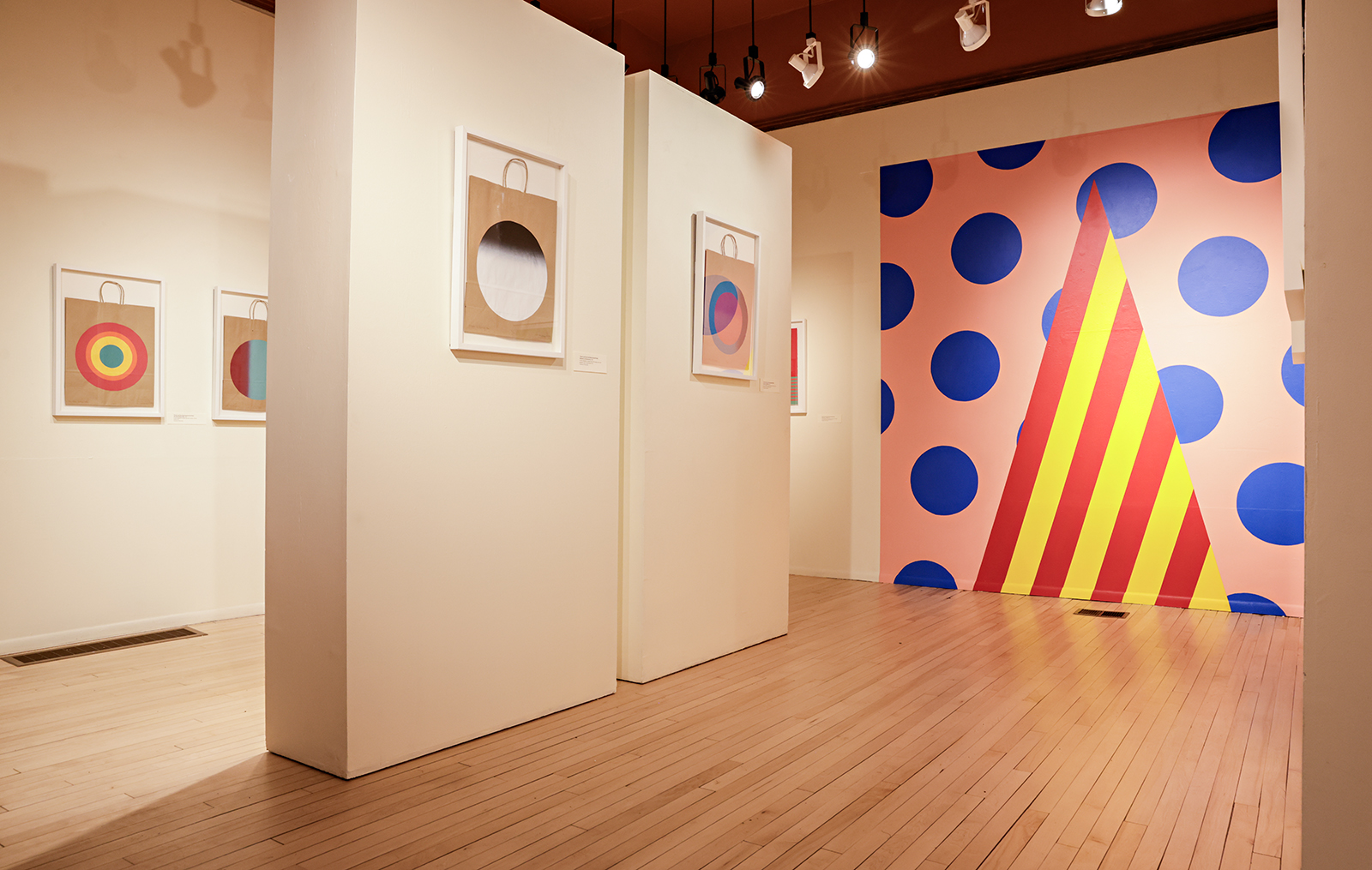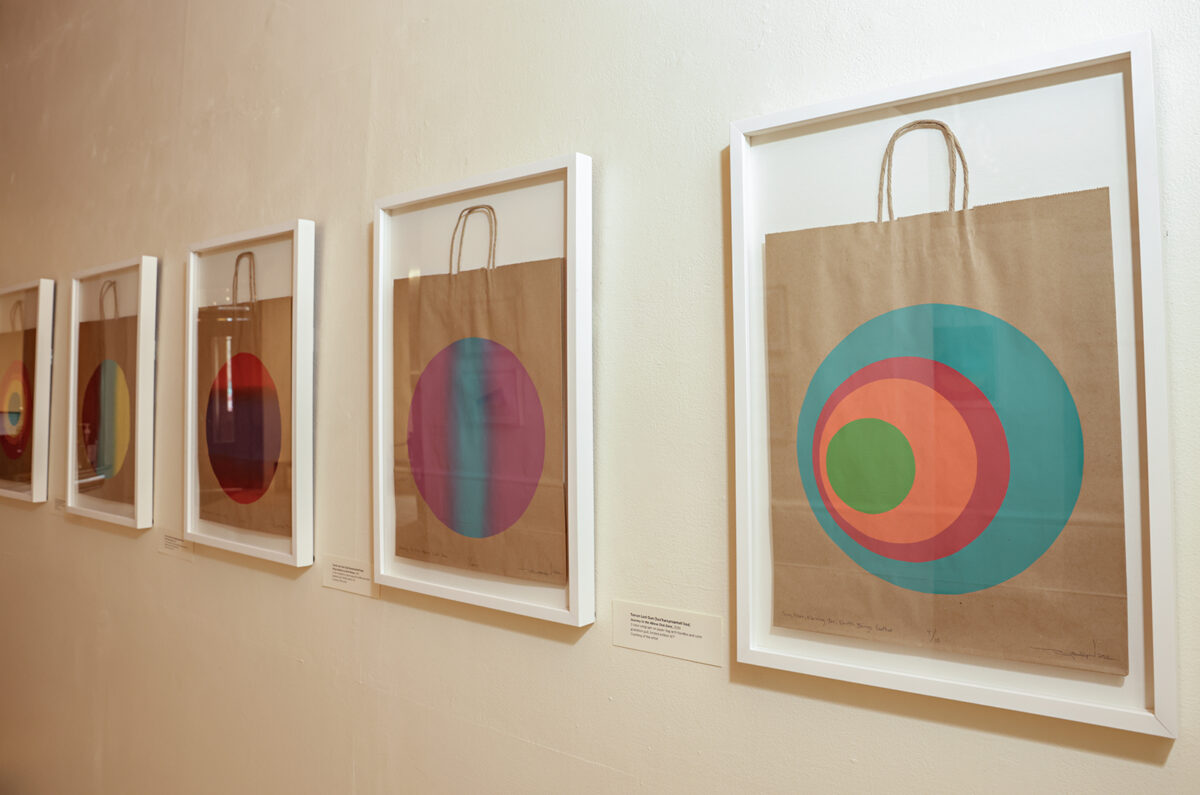With Hockaday Exhibition, Artist Terran Last Gun Brings Past and Present Together
Last Gun says his art references traditional Piikani painted lodges and other traditional cultural imagery, and then reinterprets those designs in ways that are both familiar and new through an artistic lens he thinks of as “Indigenous geometric abstraction.”
By Mike Kordenbrock
Before his “Piikani Visual Sovereignty” exhibition at the Hockaday Museum of Art in downtown Kalispell officially opened up in early April, the Piikani artist Terran Last Gun had one last piece to finish.
The bulk of the exhibition consists of vibrantly colored drawings and serigraph screen printings largely inspired by Blackfeet cosmology, culture and history, overlaid onto simple materials like brown paper bags, or old ledger paper. But to bring everything on display together into one focal point, Last Gun felt he needed to paint something on the walls of the gallery itself.
That finished mural, called “Layered in Land and Cosmos Experiences,” uses bright, solid colors and neatly formed shapes with clean lines to create an image that speaks simultaneously to the past and present, and even the future, in the distinct way that drives much of Last Gun’s creative work.
The artist said that he often asks about such mural opportunities ahead of new exhibitions, and that he documents them with photos before they’re painted over and gone. These temporary works of art, and the public way in which Last Gun creates them — in this case, inviting people to drop by and ask questions, and allowing the museum to have a camera running to create a time-lapse video — also invite people to engage with Last Gun and his art in a deeper or more personal way.
The incorporation of the mural into Last Gun’s exhibit is something that the Hockaday’s executive director Alyssa Cordova said she supported, saying that she has long appreciated artists who do site-specific work. The public demo with Last Gun as he created the mural, and an artist talk to open up the exhibition, were sponsored, in part, by a grant from Humanities Montana.
“Not all art is meant to be permanent. Like nature, nature is fleeting, and it changes and it evolves. And so the idea is that you’ve come here, experienced that artwork, but it’s not meant to last forever except in memory or story. So that’s kind of the concept behind this,” Cordova said.
Like in the case of the Hockaday mural, Last Gun sometimes arrives with a preliminary sketch to work from, but then determines specific colors that will fill in the mural after he arrives on site. Standing at the center of Last Gun’s Hockaday mural is a tall triangle, striped over with solid bands of red and yellow. Behind the triangle is a backdrop of soft pink dotted with bold blue circles.
The central shape is Last Gun’s depiction of a traditional painted Blackfoot lodge. The angular nature of the red and yellow lines that adorn its front are meant to evoke some of the sharp angles of the mountain faces and buttes that stand on what is traditionally Blackfeet territory. The blue spheres are meant to represent the cosmos and stars, which play a role in Blackfeet origin stories, and often figure into Last Gun’s other work.

What Last Gun says he’s doing as an artist with this particular mural, and with other works of art, is referencing traditional Piikani painted lodges, as well as war shirts, hides, and other artifacts, and then reinterpreting their designs in ways that are both familiar and new through an artistic lens he thinks of as “Indigenous geometric abstraction.” In the case of the lodge, Last Gun said that it might normally be depicted as a triangle with multiple other triangles surrounding the base, but that he likes to focus on one single figure and give it more prominence so that it stands out.
In focusing so much of his work, including this mural, on depictions of land shapes and cosmos shapes, Last Gun said that he is also respecting the traditional Blackfeet taboo on duplicating the design on someone else’s painted lodge, which oftentimes featured animals or something more specific to the owner. Other Western artists haven’t been so considerate of that, Last Gun said, adding that it doesn’t sit well with him. Painted lodges are still used to this day, Last Gun noted. He described his art work as in some way part of an effort to keep the style of art going even as he reimagines it.

“Everyone can do what they want, when it comes to art. But I think I’ve just made it a point to really look at those lodges and sort of dissect them and reconfigure these shapes into new shapes, and modernize them a little more. Which is a continuum to me,” he said. “This is a continuum of all these symbols, and just keeping them alive in a different way.”
The way in which those painted lodges figure into Last Gun’s sense of identity both on a personal and artistic level is also part of how he came to exhibit work at the Hockaday in the first place.
In late 2021, the museum opened up an exhibit built around the work of Sstaniiniki, a Blackfeet woman also known as Cecile Black Boy. From 1939 to 1942, Sstaniiniki worked for the Works Progress Administration’s Federal Writer’s Project by traveling through the traditional Blackfeet homeland where she collected stories and drew pictures, including of the traditionally painted lodges that she encountered. That work, alongside other lodge drawings contributed by members of the Blackfeet Nation, was loaned to the Hockaday by the Museum of the Plains Indian in Browning for the 2021 exhibit.
Last Gun, who was born in Browning, but is based out of Santa Fe, New Mexico, happened to be back in the area when the Sstaniiniki exhibit opened up, and he struck up a conversation with museum director Alyssa Cordova when he came down to see the exhibit. She eventually found out Last Gun was an artist. That conversation led her to his work, which she said she fell in love with, and they started talking about putting together an exhibition at the Hockaday.

Cordova said that it’s rare, in her experience, to have an artist visiting another exhibit be the genesis for a future exhibition, but she said in this particular instance she thinks that the Hockaday’s relationships with the Blackfeet Nation, which in this case helped bring the Sstaniiniki exhibit to town, helped make this happen. The exhibition actually marks the second time Last Gun’s art has been showcased in Kalispell in the last year, with it having previously been featured at Tessa Heck’s downtown Good Luck Gallery.
Adding another distinct layer to Last Gun’s exhibit, is that he’s the second member of his family to have their work showcased at the Hockaday. Cordova said she didn’t realize when she first started talking with Last Gun that the Hockaday had previously hosted a solo exhibition of his father, the Blackfeet painter and ledger artist Terrance Guardipee. For some of his art work, Last Gun says he’s even used ledger paper that was first acquired by his father. In some cases where the ledger paper was used can offer another layer of meaning to the artwork. Ledger paper that Last Gun said was used in Choteau, for example, can become a way for him to go about “reclaiming and reaffirming my identity and my nation, the Piikani nation” knowing that the Choteau area is part of traditional Blackfeet territory.

But he said that while much of his art is culture based, not all of it is. Among the other influences, are his own experiences.
“It’s other things that I’m seeing out in the world, like the landscape,” Last Gun said. He’s also endlessly interested in things like maps of planets and stars, and how those bodies are arranged in space. “So I’m pulling from all these different areas to get to these shapes and colors.”
Last Gun said that his artistic background lies in printmaking, something that he studied at the Institute of American Indian Arts. Many of his prints are transposed onto brown paper bags, which he said he started doing during his days as an art student, at first simply because the materials were easy to access. Eventually, though, he developed an artistic attachment to the humble material, saying that the brown paper bags as a background make the colors he works with pop, and that it’s visually interesting to elevate such an ordinary object by painting on it and framing it. Part of what Last Gun gets out of opening up a mural to visitors while it’s being painted is a sense of how they experience the painting, and more specifically how it makes them feel. It’s something that continues to fascinate him as an artist.
“I think color and shape create mood, create different types of feelings. They can spark a memory of something, maybe for someone,” Last Gun said. “There’s just so many different things that color and shape can activate in someone.”
Terran Last Gun’s “Piikani Visual Sovereignty” exhibition at the Hockaday Museum of Art in Kalispell will run through June 22. For more information, go to hockadaymuseum.com.